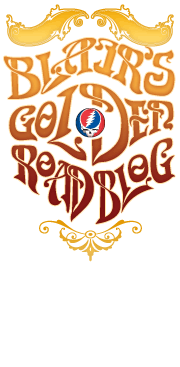Chances are you’ve encountered some of Paul Grushkin’s remarkable books through the years. His first, a collaboration with his photographer brother, Jonas, and designer Cynthia Bassett, was one of the best ever produced about our favorite group — Grateful Dead: The Official Book of the Dead Heads, published in 1983, and still a timeless document of the band and scene. With its hundreds of historical photos, copious examples of Dead-related artwork, revealing and often funny snippets of articles about the Dead and letters to the band, the book is a trip in itself. What a wondrous time machine it is!
Grushkin has produced several other exceptional books, too, including his beautiful, gargantuan, definitive volume on concert posters, The Art of Rock: Posters from Presley to Punk, and its striking and impressive sequel, The Art of Modern Rock: The Poster Explosion (with Dennis King). Then there is the more specialized Treasures of the Hard Rock Cafe (with Joel Selvin), Rockin’ Down the Highway: The Cars and People That Made Rock Roll and Art of Classic Rock: The Rob Roth Collection. Each is a sumptuous visual feast.

Photo: Mary Eisenhart ©2011
With his latest book, Grushkin returns to the Grateful Dead for a warm, witty and eye-popping companion to his Book of the Dead Heads. Dead Letters: The Very Best Grateful Dead Fan Mail (just out from Voyageur Press) serves up hundreds of examples of cool, weird, colorful, funny, deranged and highly psychedelic envelopes that were sent to the Dead’s ticket office—GDTS (Grateful Dead Ticket Sales) between 1983, when the group introduced its mail-order system, and 1995. (Additionally, there are splendid envelopes from the post-Garcia era incarnation of the company, GDTS TOO, which has continued the fine work of its predecessor.) The senders of these envelopes hoped that their sometimes very elaborate envelopes would capture the imagination of folks filling the ticket request orders and help them overcome daunting numerical odds for being granted the precious ducats. It occasionally worked. Maybe more than occasionally.
The author organizes the fan art into 10 main thematic categories, including Skulls & Skeletons, The Stealie, Bears & Terrapins, Dead Head Transportation, ’Shrooms, Tie Dye & Flying Eyeballs, plus a trippy catch-all chapter dubbed “The Second Set” and the aforementioned nod to GDTS TOO.
It’s more than just art, too. Grushkin and the author of the endearing and informative foreword, Bill Walton, engagingly lay out the history of the band’s relationship with its fans, from the earliest days to the famous “Dead Freaks Unite!” clarion call in the gatefold of their 1971 “Skull & Roses” album (which started the group’s mailing list) to the formation of GDTS and all that entailed. Grushkin offers a lively commentary on the fan art and also explains the occasionally obscure origins of all of the group’s major iconographic symbols. We also get to meet some of the colorful people behind the scenes. Some names you may know—such as the Dead organization’s main liaison with the fans, Eileen Law, and GDTS’ Calico and Steve Marcus—and others you probably don’t.
Grushkin had been trying for many years to do a follow-up to Book of the Dead Heads, but every time it seemed as if it might be on track, it became mired in one of the frustrating bureaucratic cul-de-sacs that have stymied many a well-intentioned project. A book of envelope art was an obvious and appealing way to go, as GDTS employees had taken it upon themselves to save thousands of their favorite envelopes through the years. Then, when Grateful Dead Productions closed down its offices a few years ago and the organization decided to partner with the University of California at Santa Cruz to house the band’s archives, some 15,000 envelopes saved by GDTS (out of who knows how many million) went down to Santa Cruz along with hundreds of other boxes of GD files, photos, memorabilia and assorted ephemera to be part of the Grateful Dead Archive. At last Grushkin had the raw material he’d need for Dead Letters all in one place!
Grushkin’s next task was to go through scores of boxes—each about three feet long and a bit more than the width of a good ol’ #10 envelope (as required by the mail-order rules). “They organized them by accession number in order of date postmarked,” Paul says as we sit at the dining room table in his Bay Area home on a hot late-September day. “You start flipping through them and there are no dividers that would indicate a particular concert or a particular run. And it couldn’t really be chronological anyway, because it wouldn’t hang together precisely. So my task became very self-created—the envelopes chosen for the book had to be on the basis of outstandingly rendered themes.

“UCSC Grateful Dead Archivist Nicholas Meriwether and Christine Bunting, head of Special Collections, let me go into the McHenry Library with my Canon G6 camera—which is pretty much a no-no in library situations, but they were really great about everything on this project. They sat me in the reading room and brought in the first big box they had, and I realized right then I was really going to have to look at every single envelope. There was no riffling through and just looking for the ‘highlights.’ Because sometimes it was the front of an envelope that was cool, and sometimes it was the back, and sometimes it might just be a corner or a little part of the artwork that caught my eye. So I was looking at the full envelope as a coherent artistic composition, and then I’d be looking for interesting details on the front or back, because you never know where they’re going turn up. Within that, I was doing a quick sort: ‘No. No. Yes. No. Yes, but I’m only going to photograph this part of this one.’ It was mind-numbing.”
Out of about 13,000 envelopes he personally examined, he photographed about 5,000, “and I ended up with all these giant thematic piles on this very table, and it turned into this supremely reductive exercise, because you know you’re not going to get 3,000 images in the book; you’re not going to get half that.” In the end he managed to squeeze in close to 500 in the 208-page book. Grushkin also tracked down other envelopes that had been saved by GDTS employees but held back from the UCSC donation (to remain in their personal collections until they were satisfied that UCSC Special Collections was as good as promised).
To better explain the arduous task of whittling down the thousands of photographed envelopes to just a few hundred, Grushkin drops a giant stack of images he rejected on the table in front of me. Every one is a gem. Why, I ask, would he reject this fantastically rendered drawing of a Chinese New Year’s dragon dancing across a particular envelope? “It’s great, isn’t it?” he says. “But the truth is I probably had 40 really good dragons to choose from, so I guess there was something about the one or two I chose that I thought were the most Grateful Dead-like.”

“Look at this envelope,” he says, showing me a totally charming reject that depicts smiling bears driving small race cars beneath the words “The Race Is On!” It had been created for the mail-in for a Dead show in Indianapolis, which also made it appealing, because Grushkin was always looking for geographic diversity within the themes. “This one would work for the ‘Transportation’ section, for ‘Bears,’ for ‘Songs,’ and being for Indianapolis. But would it trump another envelope in any of those categories? In this case it did not. But it was close!” he laughs. “In the end I had to use my intuition of what was ‘best in a Grateful Dead way’ and what served the overall.”
He notes that he wasn’t only drawn to the most skilled works, either. He opens up the book and points to a roughly drawn image in the hallucinatory “Second Set” chapter. “Why is this included?” he asks, pointing to a simple but evocative envelope with just “THE DEAD” scrawled messily in marker, a sun or star sketched hurriedly between the two words. “Because in some mysterious way, they got it! That’s Grateful Dead, that’s ‘second set’! It’s crude and it’s rude, but it was drawn by somebody who obviously understands ‘second set’ and what it does to your mind.”
Once Grushkin had chosen the images and they had been scanned (by UCSC), he had to get permission from the creators of the envelopes for them to appear in the book. Though the envelopes themselves no longer technically belonged to the artists — they became part of the GDTS collection once they were mailed—to publish them in a commercial product required the artists’ OK. Not surprisingly, everyone was happy to have their artwork displayed in Dead Letters — that is, the ones they could track down. “We solicited an approval from every person in that book, plus another thousand, because we weren’t sure how many of them we could find,” Grushkin says. “All we had in most cases were old addresses on the envelopes. Some of them could have moved 20 times! I moved. I don’t know if they could have tracked me down, and I didn’t move that far.” Several artists’ envelopes are showcased specially apart from the themes, accompanied by short profiles. But, alas, there are a few artists who could not be tracked down despite Grushkin’s and Voyageur’s best efforts.
“What’s that line from ‘High Time’? ‘Nothing’s for certain, it can always go wrong.’ It seemed like that every day!” Grushkin says with a chuckle. But in the end it all miraculously fell together, and the finished book is as special in its own way as Book of the Dead Heads is. No other group has ever inspired as much adventurous creativity from its fans as the Dead, and Dead Letters proves that irrefutable point once again.

“Could the decorated envelope phenomenon have happened for any other rock band?” Grushkin asks. “Dave Matthews? Tom Petty? The Rolling Stones? Possibly The Beatles? Probably not, because only the Dead gave their fans free rein to recast every icon there ever was, and shed their own light, decoratively speaking, on every aspect of their career—songs, concerts, venues, tours, you name it. It may be the only time in rock ’n’ roll history that one fandom’s artworks spoke as interpretively as the band’s music itself.”
Anyway, very cool book. You’ll dig it.
Copies are available here.





